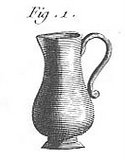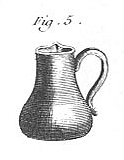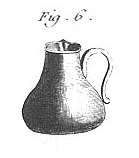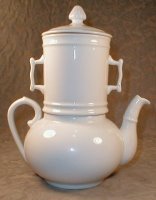
Blanchette, p. 59.
The following is my paraphrased summary of pouring pots from thesis: Blanchette, Jean-Francois (Ph.D.: Anthropology, 1979, Brown University) Title: The role of artifacts in the study of foodways in New France, 1720-1760 : two case studies based on the analysis of ceramic artifacts.
"The shapes of ceramic objects are generally divided into two categories: hollowware (creux) and flatware (platerie). Brown faïence hollowware comprises pitchers, coffeepots, chocolate pots, teapots, soup tureens, huguenotes, pâtés, deep platters or saladiers, large bowls, porringers and cups.
 The pitcher is a pot with a slight pouring lid and a handle. Its neck is long, straight and vertical; its body is globular.
The pitcher is a pot with a slight pouring lid and a handle. Its neck is long, straight and vertical; its body is globular. The coffeepot is a pouring pot in which the walls are uniform and slanted toward the bottom and the handle is horizontal and straight “used for heating all type of beverages” (Encyclopédie 1765: Fayancerie, PL I: 4) The author does not make a distinction between the coffeepot,
The coffeepot is a pouring pot in which the walls are uniform and slanted toward the bottom and the handle is horizontal and straight “used for heating all type of beverages” (Encyclopédie 1765: Fayancerie, PL I: 4) The author does not make a distinction between the coffeepot,
the marabout (round-bodied hot water jug [Fig. 5])
 and the coquemart [Fig. 6] (see text of the encyclopedia). Furetière 1970, however, says that the “coffee pot” is a “small coquemart-shaped vessel in which coffee is prepared.”
and the coquemart [Fig. 6] (see text of the encyclopedia). Furetière 1970, however, says that the “coffee pot” is a “small coquemart-shaped vessel in which coffee is prepared.” The teapot is a pouring pot with a bulbous body, narrow opening and long cylindrical and sometimes curved spout.
 It has a handle, and the spout is separate from the pot’s opening. The teapot usually stands lower than other pots of normal size. In the Recueil de plances (1765 in Encyclopédie: Fayancerie I:7), it states “A tea pot to be used with a tray (name given to a platter carrying a number of coffee cups), usually made to contain coffee.”
It has a handle, and the spout is separate from the pot’s opening. The teapot usually stands lower than other pots of normal size. In the Recueil de plances (1765 in Encyclopédie: Fayancerie I:7), it states “A tea pot to be used with a tray (name given to a platter carrying a number of coffee cups), usually made to contain coffee.”
 This text is probably another indication that tea was not widely used.
This text is probably another indication that tea was not widely used.It is only in the text of the Encyclopédie itself that the teapot is described as a pot to be used for tea: “Tea pot (Faïence manufacturer’s terminology), slightly bulbous vessel with handle and spout, in which tea is brewed with boiling water and used as a beverage. Tea pots come in all shapes and sizes, and may hold from one to ten cups; Chinese and Japanese tea pots are perhaps among the most beautiful."
From these texts, it would appear that the function of the pouring pot(s) must have varied according to the needs of the people."

10 comments:
Thanks for posting this educative writeup. I do appreciate your efforts.
Thanks for such a fantastic blog.
It’s really a great and helpful piece of information
It was so bravely and depth information. I feel so good read to your blog.
I’m glad that you shared this helpful info with us.
This is one of the best website I have seen in a long time thank you so much.
This is a really interesting and informative content.
Great post, beautiful weblog with great informational content.
I’m hoping to check out the same high-grade blog posts by you later on as well.
가상축구 패턴
가상스포츠
가상스포츠 사이트
I have to thank you for the efforts you’ve put in penning this blog.
Post a Comment